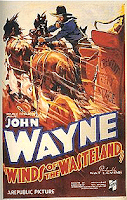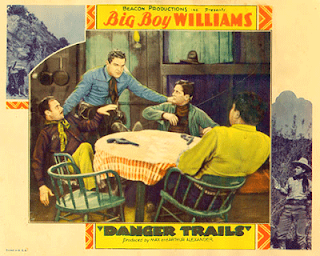 While major studios staged decadent productions that took months to shoot on bloated budgets of millions, there were numerous studios in Hollywood that were lean, fast, and hungry.
While major studios staged decadent productions that took months to shoot on bloated budgets of millions, there were numerous studios in Hollywood that were lean, fast, and hungry. Collectively known as "Poverty Row," they shot entire films in a matter of days, wrote scripts on the fly, and filmed scenes wherever and whenever they could get a camera rolling. Dismissed as the purveyors of “B-pictures,” their work has been marginalized.
And yet there are riches that came from Poverty Row, glittering jewels such as Republic Picture’s The Quiet Man, winner of the Academy Award for Best Director (John Ford) and Best Cinematography, as well as nominated for 5 other awards in 1952.

Another Poverty Row gem, Detour, is a 1945 film-noir classic from PRC Pictures (Producers Releasing Corporation) that film critic Roger Ebert describes as “haunting and creepy, an embodiment of the guilty soul of film noir.”

 Were it not for Sol Lesser and Principal Productions, we would not have a record of baseball great Lou Gehrig co-starring in a charming little B-movie called Rawhide (1938). The plot has Gehrig retiring from baseball and moving to a ranch out west with his sister to become a cowboy. The film was shot and released just a year before Gehrig was diagnosed with his fateful illness.
Were it not for Sol Lesser and Principal Productions, we would not have a record of baseball great Lou Gehrig co-starring in a charming little B-movie called Rawhide (1938). The plot has Gehrig retiring from baseball and moving to a ranch out west with his sister to become a cowboy. The film was shot and released just a year before Gehrig was diagnosed with his fateful illness. Ladies Crave Excitement (1935) is a screwball comedy that captures the essence of competing independent American newsreel companies in a fun, depression-era romp from Mascot Pictures. The film provides a historical snapshot, albeit on a small budget, of what it was like shooting and editing newsreels for movie audiences before the advent of television.
Ladies Crave Excitement (1935) is a screwball comedy that captures the essence of competing independent American newsreel companies in a fun, depression-era romp from Mascot Pictures. The film provides a historical snapshot, albeit on a small budget, of what it was like shooting and editing newsreels for movie audiences before the advent of television. Winds of the Wasteland (1936) was the first of the early John Wayne Lone Star westerns produced following the merger of Mascot Pictures with Republic Pictures. The back story involves the demise of the Pony Express after the arrival of the telegraph. The plot involves two former riders trying to form a stagecoach service, only to be swindled by the crooked owner of an established stagecoach line. The climax features a thrilling stagecoach race featuring veteran stuntman Yakima Canutt, who years later supervised the famous chariot race in William Wyler's Ben Hur (1959)
Winds of the Wasteland (1936) was the first of the early John Wayne Lone Star westerns produced following the merger of Mascot Pictures with Republic Pictures. The back story involves the demise of the Pony Express after the arrival of the telegraph. The plot involves two former riders trying to form a stagecoach service, only to be swindled by the crooked owner of an established stagecoach line. The climax features a thrilling stagecoach race featuring veteran stuntman Yakima Canutt, who years later supervised the famous chariot race in William Wyler's Ben Hur (1959) These and countless thousands of other B-movies from Poverty Row were films that captivated and entertained audiences at local Bijou's around the country during the 1930s, 40s and 50s, and were afforded an afterlife as low-cost broadcast staples that dominated local TV stations nationwide during the early years of the new mass medium.
These and countless thousands of other B-movies from Poverty Row were films that captivated and entertained audiences at local Bijou's around the country during the 1930s, 40s and 50s, and were afforded an afterlife as low-cost broadcast staples that dominated local TV stations nationwide during the early years of the new mass medium. This myriad mass of crowd-pleasing Poverty Row movies and cliff-hanging serials remain an integral part of numerous childhood memories; for many, they were our first introduction to classic films produced during the Golden Age of Hollywood.
It’s time to give Poverty Row the long-overdue respect it deserves and to celebrate the role of these studios in classic film history. Like visiting a flea market for vintage films, some of what you find will be junk, but be assured you will find lesser-known gems that are buried treasure—all waiting to be discovered anew by a new generation of film lovers.
 John Galbraith was co-creator and one of the producers of the original Matinee at the Bijou series on PBS. John originally wrote this back-story on Poverty Row Studios for our 3rd season Bijou program guide.
John Galbraith was co-creator and one of the producers of the original Matinee at the Bijou series on PBS. John originally wrote this back-story on Poverty Row Studios for our 3rd season Bijou program guide._________________
By the end of the 1920s both silent movies and the New York Stock Exchange were rapidly coming to the end of the trail. The economy was sinking into a quagmire of confusion and rising unemployment and the Great Depression quickly shrouded the nation under a gloomy cloak of uncertainty.
The movies too had fallen on hard times as the great silent stars and their studios scrambled to meet the challenges of the latest technological invention: talkies. Audiences nervously chuckled, then openly guffawed at the tenor whine of romantic leads like John Gilbert and strained to understand the dialogue emanating from screen idols with thick foreign accents.
 The great Hollywood dream factories wasted little time mooning over the demise of the silents, however, and soon film palaces were alive with extravagant sound musicals, bigger-than-life screen romances and a cavalcade of new stars anything to reassure the public that movies were still your best entertainment.
The great Hollywood dream factories wasted little time mooning over the demise of the silents, however, and soon film palaces were alive with extravagant sound musicals, bigger-than-life screen romances and a cavalcade of new stars anything to reassure the public that movies were still your best entertainment. By the mid-thirties a trip to the theater offered a Depression-weary public newsreels, comedy shorts, cartoons and serials before the neighborhood theater’s double features. It is here, in the shadow of the mammoth Hollywood studios, that the Poverty Row independents began to thrive.

Companies with names like Chesterfield, Invincible, Mascot, Puritan, Lone Star, Preferred, Colony, Tiffany, World-Wide, Quadruple, Big 4, and Majestic began churning out an amazing volume of 50-60 minute “action” features.
The small independent filmmakers could ill afford expensive sound stages and fancy effects. For them a camera, a truck, a few actors and a sunny day up at the old Warner’s movie ranch or at Eagle Rock in the San Fernando Valley was all that was needed. With this in mind it’s easy to see why the outdoor Western became the staple of those early Saturday afternoon matinees.
 Once the location work was finished on a picture, the producer would then rent a sound stage for the wrap up. The time spent in these rental stages was kept at a bare minimum, and the use of gimmick effects to cut costs became a minor art form. If a director lost a shot, for example, the film editor would not hesitate to use generous portions of stock footage borrowed from more lavish productions. To avoid paying a studio orchestra, most Poverty Row companies mixed in prerecorded or canned music to give their final product a more expensive flavor.
Once the location work was finished on a picture, the producer would then rent a sound stage for the wrap up. The time spent in these rental stages was kept at a bare minimum, and the use of gimmick effects to cut costs became a minor art form. If a director lost a shot, for example, the film editor would not hesitate to use generous portions of stock footage borrowed from more lavish productions. To avoid paying a studio orchestra, most Poverty Row companies mixed in prerecorded or canned music to give their final product a more expensive flavor.In 1935 the average cost of a low-budget or “B” picture was from $10,000 to $30,000 for a feature western, and between $45-60,000 for a serial adventure.

The “stars” of these epics fell into two main categories. First there were the fallen angels from the silent era or those who had been dropped from the major film producers like Warner Bros., MGM or Paramount. Names like Ken Maynard, Hoot Gibson, Guinn Big Boy Williams and Harry Carey soon became the staple of Gower Gulch action pictures.

In the second category were a wealth of newcomers who sparkled briefly on the matinee screen but soon fell into oblivion. These hard-working Poverty Row actors never became household words, but to the front-row kid of the thirties, forties and fifties, Bob Custer, Buzz Barton and Buffalo Bill Jr. shone more brightly than any of Hollywood’s screen royalty.
 The maneuvering for the B-movie market continued through the thirties until three main Poverty Row studios emerged as the winners. Absorbing most of the Gower Gulch independents, Monogram, PRC (Producers Releasing Corp.) and Republic Pictures dominated the matinee marquees for the next twenty years.
The maneuvering for the B-movie market continued through the thirties until three main Poverty Row studios emerged as the winners. Absorbing most of the Gower Gulch independents, Monogram, PRC (Producers Releasing Corp.) and Republic Pictures dominated the matinee marquees for the next twenty years.
Of these Republic was the indisputable king of the B’s. From 1935 to 1956 Republic produced and released approximately fifty-five pictures a year and sixty serials. During those years Republic elevated the budget genre to unparalleled heights.

The films seldom took more than a week to complete, yet they had a technical quality and a certain literate efficiency that was highly respected throughout the film industry. With the coming of television and rising production costs, however, Republic eventually succumbed and closed their doors in 1959.
The cowpokes of Gower Gulch and the companies along Poverty Row are all merely words in a few history books now. Off into the sunset are the likes of Tex Ritter, the Range Busters and Roy Rogers. But on Matinee at the Bijou the spirit and tradition of their films will live on and once again thrill new audiences with thundering heroics, frontier justice and silver six-guns that never seem to run out of bullets.
__________________________________
 Our favorite Poverty Row movie connoisseur, Greg Luce, offers 50, count 'em, 50 budget-priced Poverty Row Studio collections over at his splendid Sinister Cinema site. Each collection includes four B-movie titles from one of the many historic poverty row studios -- including Monogram, Mascot, Majestic, Mayfair, Tiffany, Puritan, Peerless, Victory, Grand National, PRC, Chesterfield, Reliable, Invincible, Ambassador, Allied, American International and Republic.
Our favorite Poverty Row movie connoisseur, Greg Luce, offers 50, count 'em, 50 budget-priced Poverty Row Studio collections over at his splendid Sinister Cinema site. Each collection includes four B-movie titles from one of the many historic poverty row studios -- including Monogram, Mascot, Majestic, Mayfair, Tiffany, Puritan, Peerless, Victory, Grand National, PRC, Chesterfield, Reliable, Invincible, Ambassador, Allied, American International and Republic.Movies Unlimited currently has on sale for $12.99 an impressive DVD Collector's Edition of John Ford's The Quiet Man with many sensational features that include a "making of" documentary, a second documentary, audio by Maureen O'hara, biographies, and trailers.
Hiç yorum yok:
Yorum Gönder